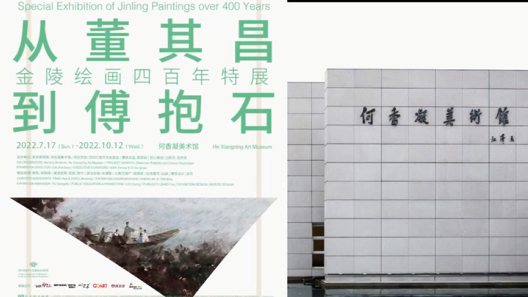EXHIBITION PERIOD: 2022.7.17 (Sat.) - 2022.10.12 (Wed.)
EXHIBITON VENUE: He Xiangning Art Museum Hall No.1-8
CO-ORGANIZERS: Nanjing Museum, He Xiangning Art Museum
EXHIBITION DIRECTOR: CAI Xianliang
CURATORS: WAN Xinhua & YI Donghua
CURATOR ASSITANTS: FANG Hua & ZHOU Jinchang
EXHIBITION COORDINATORS: CHENG Bin & FAN Ning
EXHIBITION MANAGER: YU Xiangzhi
PUBLIC EDUCATION & PROMOTION: LUO Siying
PUBLICITY: ZHAO Yue
EXHIBITION DESIGN: LIANGFENG Design
Nanjing, “Ancient Capital of Six Dynasties”, is a famous historical and cultural city in China. During the Warring States period, King Wei of Chu built a city at Shitou Mountain and first set up Jinling. In 210 B.C., the First Emperor of Qin Dynasty abolished the former cities of the six kingdoms, and changed the name Jinling to Moling during his eastern tour. Since then, Jianye, Jianye, Jiankang, Yingtian, Nanjing and Tianjing, have all been the names of this city.
Nanjing, nestling under mountains and surrounded by rivers as well as "coiling dragon and crouching tiger", has gorgeous landscape, ancient town and profound humanities, where fills with charming characters and literary prosperity. By gathering here, many celebrities and literati brought this ancient city the unique Humanities, for example, Wang Xizhi and Wang Xianzhi, the father and son from the court in Wu Yi alley, Liu Xie, the declining aristocrat living in temple and completing the "Wen Xin Diao Long", Xu Xi, the artist of the Southern Tang Dynasty who created art by splashing ink, etc. Literati and artists displayed their talents here freely, enjoyed their wonderful life and left us the precious cultural heritages. After the late Ming Dynasty, the wealthy market economy, the cultural tradition with long history and the beautiful natural landscape over there won numerous poets and artists to praise the city itself by their works, which made this city with richer artistic atmosphere and multitudinous well-known operas, novels and paintings. Cultural flourishment, economic prosperity, open lifestyle, the advantageous painting-related policies and the large group of merchant prince and artworks connoisseurs, all these factors made Jinling like a magnet to the talented, for it not only cultivated a smart of local-based artists but also attracted painters or calligraphers from all over the country. Their art styles were different from the authentic “Loudong” style or innovative “Yangzhou” style. During the early Qing Dynasty, a group of talented, such as Kun Can, Shi Tao, Gong Xian, Fan Qi, Gao Cen, Zou Zhe, Wu Hong, Ye Xin, Hu Zao, Xie Sun, emerged in Jingling. They came to Jinling and settled down, which could be called “an unprecedentedly grand occasion”. As the head of the “Eight Masters in Jinling”, Gong Xiang said:“Nowdays, Jiangnan is the place that has the most extraordinary artists, and among the fourteen provinces in Jiangnan, the capital Jinling has the most. There were around ten most celebrated artists and more than thousand of residents good at ink work.” They lingered around the urban or the suburb, lost in the memory of the old dynasty, kept drawing, doing calligraphy and composing poem, as well as sold their works or gave lessons. These works came with different styles. Some were with the elegance style belongs to “Nanzong” and “Wumen”, some were with the preciseness and sumptuousness belongs to court or government’s style , and some were with the natural leisureness. And about the artists, they were literati, professional painters or half-literati-half-painter. The artists from different sects, with different art styles, were pursuing their artistic goals synchronously while exchanging their thoughts, which caused a generally similar aesthetic interest and art tendency in Jinling art circle then and created a rich and colorful diversified environment.
Compared with the profound history and humanities of Jinling, Shenzhen in Lingnan area is slightly “young and immature” with only 40 years’ urban development. Shenzhen, where the average age of people is 32 years, has always been innovative, inclusive and multicultural. The gross domestic product of Shenzhen is as high as two trillion, which is the guarantee for the city’s culture, art and construction of civilization in the visible future. The two cities are thousands of miles apart yet communicate through art. It is an exact dialogue between classical and modern: Understanding current cultural innovation under classical contexts, seeing classical value in contemporary time and space. As a public welfare service institution, He Xiangning Art Museum are dedicated to make due contributions to Shenzhen’s spiritual construction and cultural life with continuous classical art thematic exhibitions. This time, we collaborate with Nanjing Museum to hold a special exhibition on the research of “Histories of Regional Paintings”. This exhibition selected about 80 sets of artworks, not only by famous artists during Ming and Qing Dynasties such as Dong Qichang, Gong Xian, Yang Wencong, Kun Can, Fan Qi, Wu Bin, but also by the modern “New Jinling Painting School”, such as Fu Baoshi, Qian Songyan, Song Wenzhi, Ya Ming who were active in Nanjing. We showcase the painting history of Jinling for hundreds of years by five units: “Former Sages in Jinling”, “Eight Masters in Jinling”, “Different Styles of Jinling”, “Heritages of Jinling”, “New Prosperity”.



